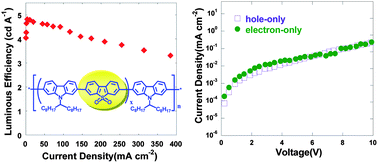Poly(N-9′-heptadecanyl-carbazole-2,7-diyl-co-dibenzothiophene-S,S-dioxide-3,7-diyl)s (PCz-SOs) were synthesized by Suzuki polycondensation. The glass transition temperatures (Tg) of the polymers increase gradually with the increase of SO unit content, and reach 119 °C for PCz-SO20. The highest occupied molecular orbital (HOMO) and the lowest unoccupied molecular orbital (LUMO) levels reduce gradually with increasing the content of SO unit in the polymers. Devices based on the polymers exhibit an excellent electroluminescent (EL) spectral stability with the variation of applied current densities in a large range of 12–360 mA cm−2. A peak luminous efficiency (LEmax) of 4.8 cd A−1 (corresponding to a maximum external quantum efficiency (EQEmax) of 3.6%) with 14 933 cd m−2 was obtained, and remained at 4.4 cd A−1 even at an applied current density of 100 mA cm−2 based on PCz-SO20 with a single-layer device of ITO/PEDOT : PSS/polymer/CsF/Al. The efficiencies were 12 times that of PCz, resulting from the balanced charge transportation in bipolar polymer PCz-SO20.

You have access to this article
 Please wait while we load your content...
Something went wrong. Try again?
Please wait while we load your content...
Something went wrong. Try again?


 Please wait while we load your content...
Please wait while we load your content...